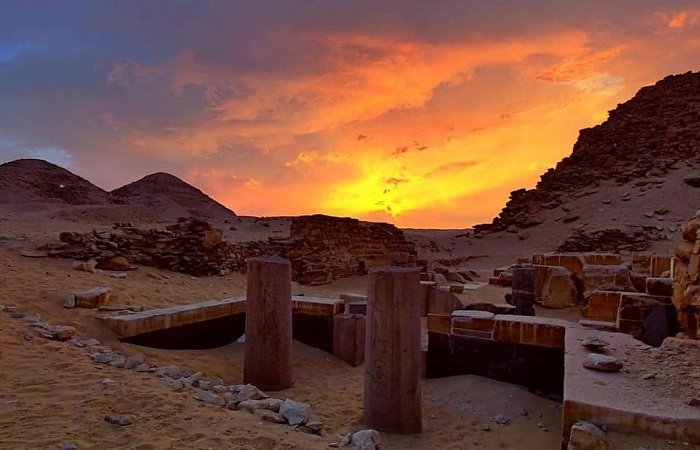Wonderful Abusir Area
Abusir Location
Abusir is located several kilometers north of Saqqara and, like it, served as one of the main elite cemeteries for the ancient Egyptian capital city of Memphis. Several other villages in northern and southern Egypt are named Abusir or Busiri.
The Name
Abusir, the House of Osiris, is the name given to an Egyptian necropolis of the Old Kingdom period. This site is rich with archaeological remains and covered by many pyramids, solar temples, and non-royal tombs. Actually.
Abusir Necropolis: pyramids of Niuserre, Neferirkare, and the temple and pyramid of Sahure.
The pharaohs of ancient Egypt’s fifth dynasty were buried primarily in the Abusir necropolis. It is located across the Nile from the ancient city of Memphis (“mn nfr”), south of Giza and north of Saqqara. The site was likely chosen because the necropolises of Giza and Saqqara were already littered with pyramids and tombs, and Abusir Lake connected the site to the river, making it easier to deliver supplies to the site by boat.
When compared to their illustrious predecessors of the fourth dynasty, the pyramids of Giza (including the Great Pyramid) and the Step Pyramid of Djoser are noticeably inferior in terms of quality and grandeur. They are largely made of local stone, which is of lower quality than the large blocks transported for miles to build the pyramids of Giza and Saqqara. This could indicate a decline in royal power, that these pharaohs had less disposable wealth, or that other pressing concerns diverted their resources away from pyramid construction.
The first pharaoh to build in Abusir was Userkaf, the fifth dynasty’s first ruler. He built the first known example of a solar temple on the site. A number of his successors built solar temples at Abusir, but chose to build burial pyramids there. Menkauhor appears to have built the last solar temple there, but this monument has yet to be located. It appears that, like Userkaf, he chose to build his pyramid somewhere else (at Dashur). After his reign, the pharaohs abandoned the necropolis at Abusir, but it remained popular among Egyptian nobles throughout pharaonic times.
There were once fourteen pyramids in Abusir’s necropolis, but only four are still visible: the pyramids of Sahure, Neferirkare, Niuserre (which is in the best condition), and the pyramid of Neferefre (unfinished). A number of smaller pyramids and mastabas at the site have largely collapsed into rubble, including a pyramid dedicated to Khentkaus II, Neferirkare’s wife, and a tomb dedicated to Ptah-Cepses (which is in poor condition). There is also an unfinished pyramid that is commonly attributed to Shepseskare. To the north at Abu Gurab, there are several Sun Temples built by the fifth dynasty’s pharaohs.
the Abusir archaeological site is known for the Abusir Papyri, the largest finding of papyri, dating from the period of the Old Kingdom.
Royal Necropolis
There are a total of 14 pyramids at this site, which served as the main royal necropolis during the Fifth dynasty.
The three major pyramids are the Pyramid of Neferirkare Kakai, the tallest pyramid at the site is the Pyramid of Niuserre, the most intact pyramid at the site, and the Pyramid of Sahure known for its finely carved reliefs.
There are smaller pyramids like the incomplete Pyramid of Neferefre, the pyramid of Queen Khentkaus II, wife of Neferirkare and mother of Neferefre and Niuserre, and some other headless pyramids.
Nobles Tombs
The tombs of several high officials and family members around the king’s pyramid: the mastaba of Ptahshepses a vizier under Niuserre, the mastaba of Prince Nakhtkare.
The tombs of Abusir-south
The lower-ranking officials of the Old Kingdom, including the following tombs: the tomb of Ity dates back to the 3rd dynasty, the tomb of Hetepi a priest, beginning of the 3rd dynasty, the tomb of Kaaper an architect and priest, 4th dynasty, the tomb of Rahotep a priest, end of 5th dynasty, the tomb of Fetekti a priest, end of 5th dynasty, and the tomb of Qar and his sons a vizier, 6th dynasty.
Ramesside temple:
it lies about 500 meters southeast of the pyramids, close to the cultivation in the desert. The main building of the temple was built of limestone.
There were three cellars, a small hall with 4 columns, and a courtyard (with mudbrick walls) with 10 limestone columns. The limestone building was placed within a larger complex made of mud bricks with a pylon and magazines.
Explore Egypt Tours Tripadvisor


Comment (0)